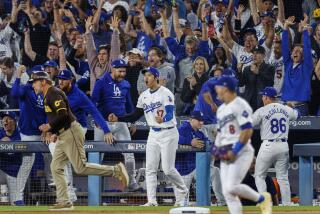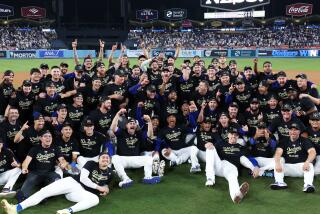This ‘Dynasty’ Canceled After a One-Year Run
- Share via
So it turned out to be The One-Year Dynasty of Mission Valley. As the playoffs begin, fans hereabouts will get “O Canada” rather than “Oh Doctor!”
Maybe the Padres are just waiting to hang their next star in 1986, The Year of the Comet.
This was definitely the year that wasn’t, at least for the local heroes. It has been called The Dive of ‘85, and Greg Louganis might have done it more artistically--but not from such an elevated platform.
After all, the Padres did a disappearing act on the National League West a year ago. They could not have gotten any further ahead--or out of sight--if they had hitched a ride on the Space Shuttle.
And so it would be in 1985. Disbelievers would be exiled to places such as Los Angeles and Cincinnati, where they might watch again from afar as the Padres disappeared once again over the horizon.
It looked like history was going to repeat itself. The Padres held that five-game lead on July 4, and every lyricist in San Diego was out in his garage with his guitar and tape recorder. Surely, another hit parade of Padre tunes would soon be in order.
But the music abruptly stopped. Whereas the Padres disappeared in 1984, their lead disappeared in 1985. They had fallen to second by the All-Star break (July 16) and never made a run at first place thereafter.
Alas, it is rather quiet in San Diego as this year’s playoffs begin. The radio waves once again belong to Bruce Springsteen, for example, and sports fans have noticed that the football season is under way.
Indeed, in 1984, the football season did not begin in San Diego until Oct. 15. That would have been the day after the World Series came to an end that tumultuous Sunday in Detroit.
It was on that date that San Diego’s sports fans looked around and wondered: “Hmmmm. How are the Chargers and Aztecs doing? Have they started playing yet?”
That was the way it was.
But not now. The playoffs are under way and the Padres can merely join the multitudes who might be wondering . . .
Will this be the first Freeway World Series--I-70 rather than I-5? Or would St. Louis-Kansas City be a “Show Me” World Series?
Will the Cardinals and Blue Jays produce the first Audubon World Series? And shouldn’t the Cardinals really be called the Roadrunners?
Or will Mexico’s Fernando Valenzuela pitch the United States’ Los Angeles Dodgers to a victory over Canada’s Toronto Blue Jays? Could this be the first real World Series--or at least Western Hemisphere Series?
Alas, I doubt that the Padres are pondering such profundities. More than likely, they are still wondering what went wrong--and when.
I have heard considerable conjecture that this series with Pittsburgh or that series with Los Angeles or maybe this other series with St. Louis is where it all turned sour. I think these were merely outward manifestations of inner stirrings.
In terms of what has happened to the Padres, there are significant dates which have not yet been considered . . .
Oct. 14, 1984--The World Series had just ended and the Padres were on buses awaiting a trip to the airport and the return flight home from Detroit after completing their greatest season.
However, the players (and other personnel) became increasingly nervous as the buses were delayed nearly an hour while mounted policemen attempted to disperse a mob amusing itself by burning police cars and taxis.
Could the players have been thinking: “If this is the World Series, who needs it?”
Dec. 6, 1984--Tim Lollar was traded to the Chicago White Sox. Yes, I know, there were others involved, but Lollar was an integral factor in the most exciting and dramatic game in Padre history.
After all, Lollar was the starting pitcher in Game 4 of the National League Championship Series. Every run was critical in making this game what it was, and Lollar gave up three of them. Without him, Steve Garvey’s ninth-inning home run would never have been frozen in time.
A franchise cannot help but suffer when it loses its sense of history.
Jan. 24, 1985--The Padres unveiled their new uniforms at a fashion show, of all things, at a Harbor Island hotel. It was the most lavish luncheon Uvaldo Martinez didn’t host of the post-holiday season.
However, during spring training, equipment manager Ray Peralta made an observation which proved painfully prophetic to this now-splendidly attired ballclub.
Noting the tremendous clamor for those ugly old orange and red and yellow and brown uniforms, Peralta said: “It just goes to show that it’s not the uniform. It’s what’s in ‘em.”
Should someone have been listening?
March 6, 1985--Steve Garvey held his annual players’ tournament in Yuma, and Eric Show played in shorts and wore neither shoes nor socks.
“If I would’ve been in his foursome,” a teammate said, “I would’ve walked off the course.”
I suspect the chap was kidding, but what if he wasn’t? Did poor Eric come up short so often because he had forgotten his plus-fours and saddle shoes? You know, no socks, no runs.
March 16, 1985--Terry Kennedy would be doubling as a catcher/sportswriter, doing the former for the Padres and the latter for a North County newspaper.
This had to be an awkward dual role, and it undoubtedly caused tension in the clubhouse. If a pitcher decided he wasn’t talking to sportswriters, for example, he could not communicate with his catcher.
And how could a sportswriter be invited to clubhouse meetings?
If he went into a slump, the players certainly couldn’t laugh should they catch him talking to himself. He could just say he was doing an interview.
June 1, 1985--By now, you have noticed that the most critical events for the 1985 Padres took place before the season even started. You’ve probably never before considered them, but I am sure you can understand their impact.
One more event was yet to come. It revealed the Padres to be intractable and unimaginative. It showed that they were unwilling to counter change with change in their quest for another first-place finish in the National League West.
This was the day the Dodgers switched Pedro Guerrero from third base to left field. This caught the Padres by surprise, but they refused to react.
It might all have ended differently if they had switched Graig Nettles to left field.
More to Read
Go beyond the scoreboard
Get the latest on L.A.'s teams in the daily Sports Report newsletter.
You may occasionally receive promotional content from the Los Angeles Times.










